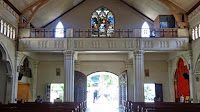Back to Main Page

 |
| Door Entrance San Agustin Cathedral |

 |
| NAVE San Agustin Cathedral |
 |
| Gaston Park and San Agustin Cathedral |


In 1622, two Augustinian Recollect missionaries first came to Huluga, then called Himologan. Here they met a mixed stock of Bukidnons and Visayas who lived in a settlement perched on a cliff, overlooking a river. The men had massive tattoos, like those of the Visayan pintados, and the women wore intricate jewelry, some made of gold.
The priests were Fray Juan de San Nicolas and Fray Francisco de la Madre de Dios. According to their journals, the natives were polytheistic animists, not Muslims. But they paid tributes to Sultan Kudarat through his emissaries.
Conversion to Christianity
In 1626, a 26-year old Augustinian Recollect friar arrived in Cagayan. His name was Fray Agustin de San Pedro, a Portuguese. Before his priesthood, he studied mathematics, architecture, gunnery, and military strategy at the University of Salamanca.
Fray Agustin persuaded the leader of Himologan, Datu Salangsang, to transfer his settlement down river, to the area of today's Gaston Park and San Agustin Cathedral. Here, Fray Agustin built a church of native materials. Inside, he baptized Datu Salangsang and his wife, and later his people.
Fortification of Cagayan
In response to the conversion, Sultan Kudarat sent a fleet of warriors to drive away the Spanish missionaries and to regain the lost tributes.
Kudarat's attacks prompted Fray Agustin to build a wooden fortress and watchtower in Cagayan to protect Salangsang's people. He called the fortress Fuerza Real de San Jose, and it occupied an area now filled with Gaston Park and San Agustin Cathedral. Fray Agustin's defense of Cagayan earned him the title "El Padre Capitan".
The fortress was rebuilt with stones in 1730. But Lt. Col. Jose Carvallo, the Spanish politico-military governor of Misamis, demolished it in 1875 and used the stones to pave the streets of the town.
Church Construction
The Recoletos made Cagayan their mission center in 1674. But only on August 28, 1780 did they declare San Agustin the patron saint of Cagayan.
In 1845, Fray Simon Loscos de Santa Catalina reconstructed the church, using marine stones from China. It had protruding buttresses and a single belfry. Inside were a magnificent altar and sanctuary with carved wooden niches and paintings.
This church was destroyed during the Japanese bombing of Cagayan in 1945, exactly a hundred years later.
Cagayan de Misamis
In 1818, the Manila Spanish divided Mindanao into politico-military districts, one of which was the Segundo Distrito de Misamis, the largest district in Mindanao. This area was composed of today's Misamis Oriental, Misamis Occidental, Camiguin, Bukidnon, Lanao, Zamboanga del Norte, and the northern part of Cotabato.
The capital was the town of Misamis, today called Ozamis City, where a fort and garrison bigger than those in Cagayan were constructed.
On February 27, 1872, the Spanish Governor General Carlos Maria de la Torre issued a decree declaring Cagayan the permanent capital of Segundo Distrito de Misamis. All Spanish politico-military governors of Misamis, who were all lieutenant colonels, lived at the Casa Real de Cagayan, built in 1831, the site of today's city hall of Cagayan de Oro. During this era, the name of the town was "Cagayan de Misamis".







No comments:
Post a Comment